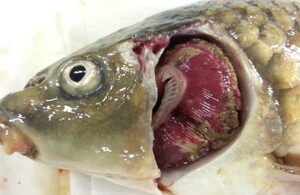Outbreaks of Koi herpesvirus (KHV) disease in 2024
The Fish Health Inspectorate (FHI) have found Koi herpesvirus (KHV) disease in fish at the following sites in England and Wales

KHV is a serious viral disease of fish and is a listed disease in the United Kingdom. It affects all varieties of common and ornamental carp species (Cyprinus carpio) and can result in large scale mortalities. Fish with KHV disease may show the following signs, especially when water temperatures are between 16 to 28 °C:
-
necrotic (white or brown) patches on the gills
-
rough patches on the skin and sloughing mucous
-
sunken eyes
You must contact the FHI if you suspect an outbreak of KHV. This includes fish with the above signs, or deaths of carp or carp hybrids.
There is no risk to public health.
Sites with KHV disease must undergo a formal monitoring programme immediately following the outbreak. The FHI visit these sites to look for evidence of disease and to inspect compliance with the conditions of the statutory controls in place.
Confirmed designation
If a notifiable disease is confirmed, FHI places controls to limit the spread of disease (these are known as confirmed designations). The following conditions are applied under disease controls:
-
No person may, without the previous consent in writing of the FHI, move any aquatic animal including eggs, and gametes, into, out of or within a confirmed designation area.
-
Disposal of dead aquatic animals, including eggs and gametes, must be by an approved method for disposal of Category 2 animal-by-product waste in compliance with local Environmental Health department requirements
-
Notify the Fish Health Inspectorate immediately should mortalities re-occur or spread to other waters/facilities within the designated area.
-
Notify the FHI in advance of all intended physical changes to sites within the designated area - such as site boundaries, number or size of waters, use of the site. FHI written permission will be required beforehand for all such changes.
-
All requests for consents required under this Confirmed Designation Notice must be submitted to the FHI with a minimum of 5 working days’ notice.
New outbreaks
When laboratory testing confirms KHV disease at a site, the FHI place statutory controls to limit the spread of the disease. These controls restrict movement of aquatic animals.
Disease controls have been applied at:
Diseases controls lifted at:
You can:
-
view all KHV disease outbreaks, their locations, and controls
-
find out more about KHV disease
-
take steps to prevent the introduction and spread of KHV disease
Background
Koi herpesvirus disease (KHV) is a listed disease under The Aquatic Animal Health (England and Wales) Regulations 2009. KHV outbreaks have been subject to statutory controls in the UK since 2007. The UK maintains a surveillance programme for this disease.
When the FHI confirm an outbreak, they take steps to control and, wherever possible, remove the disease. This may involve movement controls on susceptible species in the affected area, enhanced biosecurity, culling of fish, and cleaning and disinfecting of the premises.
Once statutory controls are in place the site operators must write to the FHI to get permission to move live fish into, out of, or within the designated area, and to make material changes to the site or site activities. This also applies to fish eggs and gametes.
Updates to this page
Last updated 22 August 2024 + show all updates
-
A confirmed designation has been listed.
-
A confirmed designation has been listed.
-
A confirmed designation has been listed.
-
A confirmed designation has been listed.
-
A confirmed designation has been listed.
-
A new confirmed designation has been listed.
-
A new confirmed designation has been listed.
-
First published.